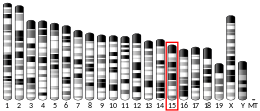NDUFA6
NADH dehydrogenase [ubiquinone] 1 alpha subcomplex subunit 6 is an enzyme that in humans is encoded by the NDUFA6 gene.[5] The NDUFA6 protein is a subunit of NADH dehydrogenase (ubiquinone), which is located in the mitochondrial inner membrane and is the largest of the five complexes of the electron transport chain.[6]
Structure
The NDUFA6 gene is located on the q arm of chromosome 22 in position 13.2 and spans 5,359 base pairs.[5] The gene produces an 18 kDa protein composed of 154 amino acids.[7][8] NDUFA6 is a subunit of the enzyme NADH dehydrogenase (ubiquinone), the largest of the respiratory complexes. The structure is L-shaped with a long, hydrophobic transmembrane domain and a hydrophilic domain for the peripheral arm that includes all the known redox centers and the NADH binding site.[6] It has been noted that the N-terminal hydrophobic domain has the potential to be folded into an alpha helix spanning the inner mitochondrial membrane with a C-terminal hydrophilic domain interacting with globular subunits of Complex I. The highly conserved two-domain structure suggests that this feature is critical for the protein function and that the hydrophobic domain acts as an anchor for the NADH dehydrogenase (ubiquinone) complex at the inner mitochondrial membrane. NDUFA6 is one of about 31 hydrophobic subunits that form the transmembrane region of Complex I. The predicted secondary structure is primarily alpha helix, but the carboxy-terminal half of the protein has high potential to adopt a coiled-coil form. The amino-terminal part contains a putative beta sheet rich in hydrophobic amino acids that may serve as mitochondrial import signal. Related pseudogenes have also been identified on four other chromosomes.[5][9][10][11]
Function
The human NDUFA6 gene codes for a subunit of Complex I of the respiratory chain, which transfers electrons from NADH to ubiquinone.[5] Initially, NADH binds to Complex I and transfers two electrons to the isoalloxazine ring of the flavin mononucleotide (FMN) prosthetic arm to form FMNH2. The electrons are transferred through a series of iron-sulfur (Fe-S) clusters in the prosthetic arm and finally to coenzyme Q10 (CoQ), which is reduced to ubiquinol (CoQH2). The flow of electrons changes the redox state of the protein, resulting in a conformational change and pK shift of the ionizable side chain, which pumps four hydrogen ions out of the mitochondrial matrix.[6]
References
- ENSG00000184983, ENSG00000272765, ENSG00000281013, ENSG00000277365 GRCh38: Ensembl release 89: ENSG00000273397, ENSG00000184983, ENSG00000272765, ENSG00000281013, ENSG00000277365 - Ensembl, May 2017
- GRCm38: Ensembl release 89: ENSMUSG00000022450 - Ensembl, May 2017
- "Human PubMed Reference:". National Center for Biotechnology Information, U.S. National Library of Medicine.
- "Mouse PubMed Reference:". National Center for Biotechnology Information, U.S. National Library of Medicine.
- "Entrez Gene: NDUFA6 NADH dehydrogenase (ubiquinone) 1 alpha subcomplex, 6".
- Donald Voet; Judith G. Voet; Charlotte W. Pratt (2013). "18". Fundamentals of biochemistry : life at the molecular level (4th ed.). Hoboken, NJ: Wiley. pp. 581–620. ISBN 9780470547847.
- Zong NC, Li H, Li H, Lam MP, Jimenez RC, Kim CS, Deng N, Kim AK, Choi JH, Zelaya I, Liem D, Meyer D, Odeberg J, Fang C, Lu HJ, Xu T, Weiss J, Duan H, Uhlen M, Yates JR, Apweiler R, Ge J, Hermjakob H, Ping P (Oct 2013). "Integration of cardiac proteome biology and medicine by a specialized knowledgebase". Circulation Research. 113 (9): 1043–53. doi:10.1161/CIRCRESAHA.113.301151. PMC 4076475. PMID 23965338.
- "NDUFA6 - NADH dehydrogenase [ubiquinone] 1 alpha subcomplex subunit 6". Cardiac Organellar Protein Atlas Knowledgebase (COPaKB).
- Emahazion T, Beskow A, Gyllensten U, Brookes AJ (Nov 1998). "Intron based radiation hybrid mapping of 15 complex I genes of the human electron transport chain". Cytogenet Cell Genet. 82 (1–2): 115–9. doi:10.1159/000015082. PMID 9763677.
- Emahazion T, Brookes AJ (Nov 1998). "Mapping of the NDUFA2, NDUFA6, NDUFA7, NDUFB8, and NDUFS8 electron transport chain genes by intron based radiation hybrid mapping". Cytogenet Cell Genet. 82 (1–2): 114. doi:10.1159/000015081. PMID 9763676.
- Ton C, Hwang DM, Dempsey AA, Liew CC (Jan 1998). "Identification and primary structure of five human NADH-ubiquinone oxidoreductase subunits". Biochem Biophys Res Commun. 241 (2): 589–94. doi:10.1006/bbrc.1997.7707. PMID 9425316.
Further reading
- Dunbar DR, Shibasaki Y, Dobbie L, et al. (1997). "In situ hybridisation mapping of genomic clones for five human respiratory chain complex I genes". Cytogenet. Cell Genet. 78 (1): 21–4. doi:10.1159/000134618. PMID 9345899.
- Loeffen JL, Triepels RH, van den Heuvel LP, et al. (1999). "cDNA of eight nuclear encoded subunits of NADH:ubiquinone oxidoreductase: human complex I cDNA characterization completed". Biochem. Biophys. Res. Commun. 253 (2): 415–22. doi:10.1006/bbrc.1998.9786. PMID 9878551.
- Dunham I, Shimizu N, Roe BA, et al. (1999). "The DNA sequence of human chromosome 22". Nature. 402 (6761): 489–95. Bibcode:1999Natur.402..489D. doi:10.1038/990031. PMID 10591208.
- Hattori M, Fujiyama A, Taylor TD, et al. (2000). "The DNA sequence of human chromosome 21". Nature. 405 (6784): 311–9. Bibcode:2000Natur.405..311H. doi:10.1038/35012518. PMID 10830953.
- Strausberg RL, Feingold EA, Grouse LH, et al. (2003). "Generation and initial analysis of more than 15,000 full-length human and mouse cDNA sequences". Proc. Natl. Acad. Sci. U.S.A. 99 (26): 16899–903. Bibcode:2002PNAS...9916899M. doi:10.1073/pnas.242603899. PMC 139241. PMID 12477932.
- Murray J, Taylor SW, Zhang B, et al. (2003). "Oxidative damage to mitochondrial complex I due to peroxynitrite: identification of reactive tyrosines by mass spectrometry". J. Biol. Chem. 278 (39): 37223–30. doi:10.1074/jbc.M305694200. PMID 12857734.
- Collins JE, Wright CL, Edwards CA, et al. (2005). "A genome annotation-driven approach to cloning the human ORFeome". Genome Biol. 5 (10): R84. doi:10.1186/gb-2004-5-10-r84. PMC 545604. PMID 15461802.
- Gerhard DS, Wagner L, Feingold EA, et al. (2004). "The Status, Quality, and Expansion of the NIH Full-Length cDNA Project: The Mammalian Gene Collection (MGC)". Genome Res. 14 (10B): 2121–7. doi:10.1101/gr.2596504. PMC 528928. PMID 15489334.
- Vogel RO, Dieteren CE, van den Heuvel LP, et al. (2007). "Identification of mitochondrial complex I assembly intermediates by tracing tagged NDUFS3 demonstrates the entry point of mitochondrial subunits". J. Biol. Chem. 282 (10): 7582–90. doi:10.1074/jbc.M609410200. PMID 17209039.
This article incorporates text from the United States National Library of Medicine, which is in the public domain.





